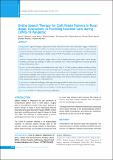Please use this identifier to cite or link to this item:
https://hdl.handle.net/20.500.14356/1028Full metadata record
| DC Field | Value | Language |
|---|---|---|
| dc.contributor.author | Nakarmi, Kiran Kishor | - |
| dc.contributor.author | Mehta, Kajal | - |
| dc.contributor.author | Shakya, Pramila | - |
| dc.contributor.author | Rai, Shiv Kumari | - |
| dc.contributor.author | Gurung, Kabita Bhattarai | - |
| dc.contributor.author | Koirala, Ruchi | - |
| dc.contributor.author | Pradhan, Bhawani | - |
| dc.contributor.author | Rai, Shankar Man | - |
| dc.date.accessioned | 2023-04-20T06:48:19Z | - |
| dc.date.available | 2023-04-20T06:48:19Z | - |
| dc.date.issued | 2022 | - |
| dc.identifier.citation | NakarmiK. K., MehtaK., ShakyaP., RaiS. K., Bhattarai GurungK., KoiralaR., PradhanB., & RaiS. M. (2022). Online Speech Therapy for Cleft Palate Patients in Rural Nepal: Innovations in Providing Essential Care during COVID-19 Pandemic . Journal of Nepal Health Research Council, 20(01), 154-159. https://doi.org/10.33314/jnhrc.v20i01.3781 | en_US |
| dc.identifier.issn | Print ISSN: 1727-5482; Online ISSN: 1999-6217 | - |
| dc.identifier.uri | http://103.69.126.140:8080/handle/20.500.14356/1028 | - |
| dc.description | Original Article | en_US |
| dc.description.abstract | Abstract Background: Speech therapy is important for ideal functional outcome after cleft palate surgery. Nationwide lockdown due to outbreak of COVID-19 in Nepal restricted the ability of patients to travel to nearby outreach centers for regular speech therapy. The objectives were to assess the feasibility and challenges of conducting online speech therapy with postpalatoplasty children during COVID-19 pandemic; and evaluate the ways to overcome them. Methods: Patients with cleft palate surgery done at least 3 months prior were given online speech therapy. Feasibility, advantages and challenges of online speech therapy were evaluated through interviewing the guardians and speech therapy providers. Results: A total of 89 patients were included in the study. Only 11.2% had secondary palatine procedures. Almost all the children (97.8%) had face to face speech therapy prior to study period. Best use of time, use of audiovisual aid, no need to travel and rapid progress were the most commonly perceived strengths of online speech therapy. The most frequent challenges were internet connectivity, unclear voice, lack of direct interaction and unstable power supply. Recommended ways to improve online speech therapy were cited as better internet connectivity, having a fixed schedule and availing free or affordable Wifi. Conclusions: Despite the challenges, online speech therapy provided us with a way to reach out to the cleft palate children when face-to-face therapy was not possible due to COVID-19 pandemic. We see its role even during non-pandemic situations for the children who are unable to visit the speech therapy centers. Keywords: COVID-19; online speech therapy; palatoplasty | en_US |
| dc.language.iso | en | en_US |
| dc.relation.ispartofseries | Jan-March, 2022;3781 | - |
| dc.subject | COVID-19 | en_US |
| dc.subject | online speech therapy | en_US |
| dc.subject | palatoplasty | en_US |
| dc.title | Online Speech Therapy for Cleft Palate Patients in Rural Nepal: Innovations in Providing Essential Care during COVID-19 Pandemic | en_US |
| dc.type | Journal Article | en_US |
| local.journal.category | Original Article | - |
| Appears in Collections: | Vol. 20 No. 01 (2022): Issue 54 Jan-March, 2022 | |
Files in This Item:
| File | Description | Size | Format | |
|---|---|---|---|---|
| 3781-Manuscript-27883-1-10-20220606.pdf | Fulltext Download | 356.4 kB | Adobe PDF |  View/Open |
Items in DSpace are protected by copyright, with all rights reserved, unless otherwise indicated.
